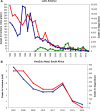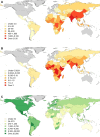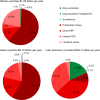Global epidemiology of canine rabies: past, present, and future prospects
- PMID: 30101121
- PMCID: PMC6067664
- DOI: 10.2147/VMRR.S51147
Global epidemiology of canine rabies: past, present, and future prospects
Abstract
The rabies virus, a public health scourge from ancient times, is currently responsible for an estimated 59,000 human deaths a year, almost all transmitted via dog bites. It causes considerable economic impacts on developing countries, primarily in Africa and Asia, which can least afford these losses. However, despite its almost 100% case fatality rate, canine rabies is a completely preventable disease, and historic examples of canine rabies elimination in the developed world attest to this. Over the last decade, programs based on eliminating the source of the disease from dogs have shown success in reducing the public health burden of canine rabies in developing countries, notably across Latin America, and this has contributed to the growing evidence base necessary to change attitudes toward the feasibility of global canine rabies elimination. More recently, assessments of the current economic burden of canine rabies and the potential cost savings achievable through mass dog vaccinations have been added to this evidence base. Tools and support are available from the international community to help countries move progressively toward canine rabies elimination, and there is optimism that global freedom from canine rabies can be achieved within the next few decades.
Keywords: canine rabies; elimination; epidemiology; rabies virus; zoonosis.
Conflict of interest statement
Disclosure The authors report no conflicts of interest in this work.
Figures



References
-
- Hanlon C, Childs J. Epidemiology. In: Jackson AC, editor. Rabies: Scientific Basis of the Disease and its Management. 3rd ed. Waltham, MA: Academic Press; 2013. pp. 61–122.
-
- Jackson AC. Human disease. In: Jackson AC, editor. Rabies: Scientific Basis of the disease and its management. 3rd ed. Waltham, MA: Academic Press; 2013. pp. 269–298.
-
- Neville J. Rabies in the ancient world. In: King A, Fooks A, Aubert M, Wandeler A, editors. Historical Perspective of Rabies in Europe and the Mediterranean Basin A Testament to Rabies by Dr Arthur King. Paris, France: World Organisation for Animal Health; 2004. pp. 1–14.
-
- Jackson AC. Recovery from rabies: a call to arms. J Neurol Sci. 2014;339(1–2):5–7. - PubMed
-
- International Committee on Taxonomy of Viruses Virus Taxonomy: 2014 Release. 2015. [Accessed June 29, 2015]. Available from: http://www.ictvonline.org/virusTaxonomy.asp.
Publication types
LinkOut - more resources
Full Text Sources
Miscellaneous

